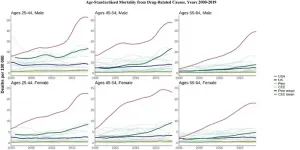By 2050, over three-quarters (155 of 204) of countries will not have high enough fertility rates to sustain population size over time; this will increase to 97% of countries (198 of 204) by 2100. Pronounced shifts in patterns of livebirths are also predicted, with the share of the world’s live births nearly doubling in low-income regions from 18% in 2021 to 35% in 2100; and sub-Saharan Africa accounting for one in every two children born on the planet by 2100. In low-income settings with higher fertility rates, better access to contraceptives and female education will help reduce birth rates, while in low-fertility, high-income economies, policies that support parents and open immigration will be vital to maintain population size and economic growth. Authors warn that national governments must plan for emerging threats to economies, food security, health, the environment, and geopolitical security brought on by these demographic changes that are set to transform the way we live. **For regional and individual-level country data, see notes to editors**
The world is approaching a low-fertility future. Although by 2100 more than 97% of countries and territories will have fertility rates below what is necessary to sustain population size over time, comparatively high fertility rates in numerous low-income countries, predominantly in western and eastern sub-Saharan Africa, will continue to drive population increases in these locations throughout the century. This ‘demographically divided world’ will have enormous consequences for economies and societies, according to a new study published in The Lancet.
The research presents estimates from the Global Burden of Disease, Injuries, and Risk Factors Study (GBD) 2021 – a global research effort led by the Institute for Health Metrics and Evaluation (IHME) at the University of Washington’s School of Medicine – for past, current, and future global, regional, and national trends in fertility and live births. In general, countries need to have a total fertility rate (TFR) of 2.1 children per person who could give birth, to sustain long-term generational replacement of the population. The TFR of a population is the average number of children that are born to a female over a lifetime, assuming childbearing at current fertility rates throughout the reproductive years.
Using novel methods for forecasting mortality, fertility, key drivers of fertility (e.g., level of education, unmet need for modern contraception, child mortality, and living in urban areas), and livebirths, the researchers estimate that by 2050, 155 of 204 (76%) countries and territories will be below the replacement level of fertility. The number of countries and territories below replacement level is predicted to further increase to 198 of 204 (97%) by 2100. This means that in these locations, populations will shrink unless low fertility can be offset by ethical and effective immigration. The extent of low fertility may also be mitigated in part by policies that offer greater support for parents.
The new fertility forecasts underscore the enormous challenges to economic growth in many middle- and high-income countries with a dwindling workforce and the growing burden on health and social security systems of an ageing population.
The new study also predicts huge shifts in the global pattern of livebirths from higher- to lower-income countries. In 2021, 29% of the world’s babies were born in sub-Saharan Africa; by 2100, this is projected to rise to over half (54%) of all babies, emphasizing the urgency for improvements in access to modern contraception and female education in these countries.
“We are facing staggering social change through the 21st century,” said senior author Professor Stein Emil Vollset from IHME. "The world will be simultaneously tackling a 'baby boom' in some countries and a 'baby bust' in others. As most of the world contends with the serious challenges to the economic growth of a shrinking workforce and how to care for and pay for ageing populations, many of the most resource-limited countries in sub-Saharan Africa will be grappling with how to support the youngest, fastest-growing population on the planet in some of the most politically and economically unstable, heat-stressed, and health system-strained places on earth.”
“The implications are immense,” said co-lead author and Lead Research Scientist from IHME Dr. Natalia V. Bhattacharjee. “These future trends in fertility rates and live births will completely reconfigure the global economy and the international balance of power and will necessitate reorganizing societies. Global recognition of the challenges around migration and global aid networks are going to be all the more critical when there is fierce competition for migrants to sustain economic growth and as sub-Saharan Africa’s baby boom continues apace.”
Declining fertility worldwide – only six countries with fertility rates above replacement level in 2100
The global TFR has more than halved over the past 70 years, from around five children for each female in 1950 to 2.2 children in 2021—with over half of all countries and territories (110 of 204) below the population replacement level of 2.1 births per female as of 2021. This trend is particularly worrying for places such as South Korea and Serbia where the rate is less than 1.1 child for each female. But for many countries in sub-Saharan Africa, fertility rates remain high—the TFR of the region is nearly twice the global average, at four children per female in 2021. In Chad, the TFR of seven births is the highest in the world.
Over the coming decades, global fertility is predicted to decline even further, reaching a TFR of around 1.8 in 2050, and 1.6 in 2100—well below the replacement level. By 2100, only six of 204 countries and territories (Samoa, Somalia, Tonga, Niger, Chad, and Tajikistan) are expected to have fertility rates exceeding 2.1 births per female. In 13 countries, including Bhutan, Bangladesh, Nepal, and Saudi Arabia, rates are even predicted to fall below one child per female.
The TFR in Western Europe is predicted to be 1.44 in 2050, dropping to 1.37 in 2100, with Israel, Iceland, Denmark, France, and Germany expected to have the highest fertility rates at between 2.09 and 1.40 at the end of the century. Rates are projected to be much lower across the rest of Europe and parts of Asia.
Most of the world is transitioning into natural population decline (when the number of deaths exceeds the number of live births); just 26 countries are still projected to be growing in population in 2100 as livebirths continue to outnumber deaths, including Angola, Zambia, and Uganda [1].
“In many ways, tumbling fertility rates are a success story, reflecting not only better, easily available contraception but also many women choosing to delay or have fewer children, as well as more opportunities for education and employment," said Vollset.
Dramatic shifts in the patterns of births – with more than half of live births occurring in sub-Saharan Africa by 2100
In the coming decades, the majority of children will be born in some of the most resource-limited regions of the world, with over three-quarters (77%) of live births expected in low- and lower-middle-income countries by the end of the century.
Fertility decline for many countries in sub-Saharan Africa is occurring at a slower pace, and the region is expected to contribute to over half (54%; around 40 million) of the world’s livebirths by 2100, up from around 41% in 2050, and around a quarter (29%) in 2021.
Much of the anticipated decline in the global share of livebirths will be in the six other super-regions—falling, for example, in South Asia —from around 25% (32 million) in 2021 to 17% (19 million) in 2050 and 7% (5 million) in 2100—but is forecasted to rise modestly in the North Africa and Middle East (from 9% in 2021 to 11% in 2100) and the high-income super-region (8% to 10%).
“A large challenge for countries in sub-Saharan Africa with the highest fertility is to manage risks associated with burgeoning population growth or risk potential humanitarian catastrophe,” said co-lead author and Acting Assistant Professor from IHME Dr. Austin E. Schumacher. “The huge shift in numbers of births underscores the need to prioritise this region in efforts to lessen the effects of climate change, improve health care infrastructure, and continue to reduce child mortality rates, alongside actions to eliminate extreme poverty and ensure that women’s reproductive rights, family planning, and education for girls are top priorities for every government.”
Solutions for a demographically divided world
“These profound changes in future fertility reveal a clear demographic divide between the impacts on many middle-to high-income nations versus many low-income locations that requires national governments to implement safe and beneficial policies to help support conditions that can increase birth rates in some regions and lower them in others,” said Schumacher. “Time is of the essence, as current efforts to manage population growth will likely only be felt after 2050.”
The analysis suggests that concerted efforts to fast-track access to modern contraceptives and female education—the two key drivers of fertility—could help accelerate declines in fertility and reduce birth rates in higher-fertility nations. For example, in sub-Saharan Africa, projections estimate that achieving the UN Sustainable Development Goals for universal female education or universal unmet need for modern contraceptives by 2030 would each result in fertility rates of 2.3 births per woman in 2050 compared with around 2.7 births if these targets aren’t met.
In the highest-fertility countries, the gains could be even greater. In Niger, for example, the total fertility rate is predicted to be five children for each female in 2050. But if the target of universal education were met by 2030, the rate is projected to decline to 2.7 children per female in 2050, while meeting universal contraceptive needs could lower the rate to 4.3 children.
“While achieving both universal targets in all locations by 2030 is likely beyond reach, it’s clear that tackling the population explosion in higher-fertility countries depends greatly on accelerating progress in education for girls and reproductive rights,” said Schumacher.
The study also examined the potential impact that pro-natal policies designed to provide financial support and care for children and families could have on increasing fertility rates in countries with below-replacement fertility. Based on existing information from countries that have already implemented such policies, the findings suggest that while pro-natal policies will not boost fertility rates up to replacement level, they may prevent some countries from dropping to extremely low fertility levels (with just 30 countries and territories below a TFR of 1.3 in 2100 if pro-natal policies are implemented compared to 94 under the most likely scenario). It will be important for low-fertility countries to implement a combination of policies that support those who wish to have children and offer additional benefits to society such as better quality of life and greater participation of women in the workforce, alongside open immigration policies.
“There’s no silver bullet,” said Bhattacharjee. “Social policies to improve birth rates such as enhanced parental leave, free childcare, financial incentives, and extra employment rights, may provide a small boost to fertility rates, but most countries will remain below replacement levels. And once nearly every country’s population is shrinking, reliance on open immigration will become necessary to sustain economic growth. Sub-Saharan African countries have a vital resource that ageing societies are losing—a youthful population.”
She continues, “There is very real concern that, in the face of declining populations and no clear solutions, some countries might justify more Draconian measures that limit reproductive rights. It is well established that nations with strong women's rights are more likely to have better health outcomes and faster economic growth. It is imperative women’s rights are promoted and protected and that women are supported in having the number of children they wish and pursuing their careers.”
The authors note some important limitations, including that while the study uses the best available data, predictions are constrained by the quantity and quality of past data, which was especially limited during the 2020–2021 pandemic period. They also note that past trends are not predictive of what will happen in the future and that these fertility forecasts rely on accurately forecasting each of the potential drivers of fertility into the future.
Writing in a linked Comment, Gitau Mburu, James Kiarie, and Pascale Allotey of the World Health Organization, who were not involved in the study, said, “Fertility is an issue that concerns multiple stakeholders and disciplines. Scientific predictions and policy discourses are essential as we all search for answers. Accurate communication will facilitate better understanding of the issue and informed decisions. Declining TFRs will challenge the global community and could prompt innovations that assist us in achieving sustainable development in the long term.”
NOTES TO EDITORS
Labels have been added to this press release as part of a project run by the Academy of Medical Sciences seeking to improve the communication of evidence. For more information, please see: http://www.sciencemediacentre.org/wp-content/uploads/2018/01/AMS-press-release-labelling-system-GUIDANCE.pdf if you have any questions or feedback, please contact The Lancet press office pressoffice@lancet.com
The study was funded by the Bill & Melinda Gates Foundation. The paper was conducted by the GBD 2021 Fertility and Forecasting Collaborators and researchers at the University of Washington, Seattle, USA.
Quotes from Authors cannot be found in the text of the Article but have been supplied for the press release. The Comment quote is taken directly from the linked Comment.
[1] There is around a 30-year gap between the time when TFR falls below the replacement level (2.1) and when the natural rate of population increase turns negative (i.e., the number of deaths will exceed the number of live births).
Tables - total fertility rates in 2050 and 2100
Top 10 country fertility rates (worldwide)
2050
2100
Niger (Western sub-Saharan Africa)
5.15
Samoa (Oceania)
2.57
Chad (Western sub-Saharan Africa)
4.81
Tonga (Oceania)
2.45
Somalia (Eastern sub-Saharan Africa)
4.30
Somalia (Eastern sub-Saharan Africa)
2.45
Mali (Western sub-Saharan Africa)
4.21
Niger (Western sub-Saharan Africa)
2.24
South Sudan (Eastern sub-Saharan Africa)
4.09
Chad (Western sub-Saharan Africa)
2.15
Burkina Faso (Western sub-Saharan Africa)
3.76
Tajikistan (Central Asia)
2.13
Afghanistan (North Africa and Middle East)
3.34
Israel (Western Europe)
2.09
Samoa (Oceania)
3.18
Egypt (North Africa and Middle East)
2.05
Benin (Western sub-Saharan Africa)
3.12
Zimbabwe (Southern sub-Saharan Africa)
2.01
Tonga (Oceania)
3.04
South Sudan (Eastern sub-Saharan Africa)
1.98
Lowest 10 country fertility rates (worldwide)
2050
2100
South Korea (High-income Asia Pacific)
0.82
Bhutan (South Asia)
0.69
Puerto Rico (Caribbean)
0.84
The Maldives (Southeast Asia)
0.77
Taiwan (Province of China) (East Asia)
0.90
Puerto Rico (Caribbean)
0.81
Serbia (Central Europe)
1.01
Nepal (South Asia)
0.82
Ukraine (Eastern Europe)
1.01
South Korea (High-income Asia Pacific)
0.82
Andorra (Western Europe)
1.02
Saint Lucia (Caribbean)
0.87
Saint Lucia (Caribbean)
1.04
Taiwan (province of China) (East Asia)
0.90
Bhutan (South Asia)
1.07
Cabo Verde (Western sub-Saharan Africa)
0.91
The Maldives (Southeast Asia)
1.07
Djibouti (Eastern sub-Saharan Africa)
0.95
Kuwait (North Africa and Middle East)
1.07
Bosnia and Herzegovina (Central Europe)
0.95
END




